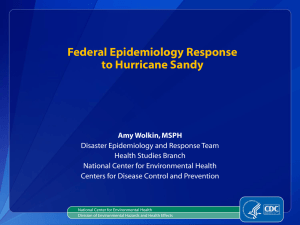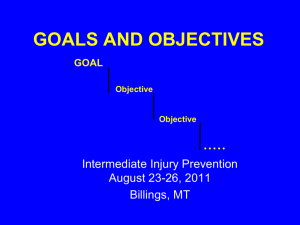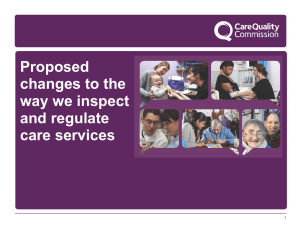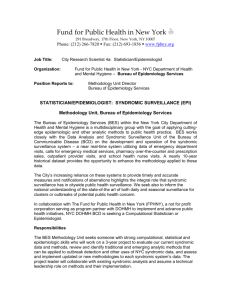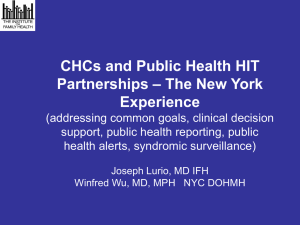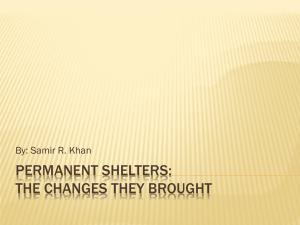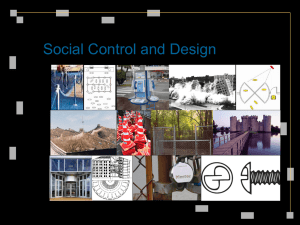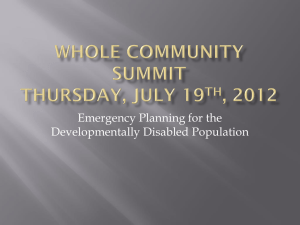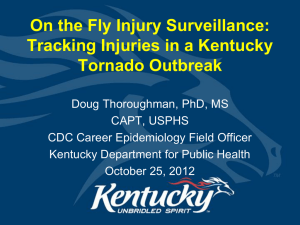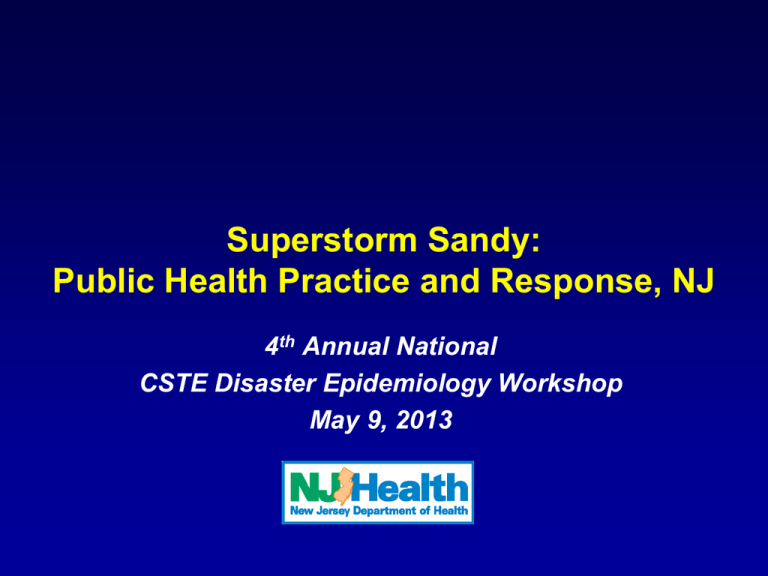
Superstorm Sandy:
Public Health Practice and Response, NJ
4th Annual National
CSTE Disaster Epidemiology Workshop
May 9, 2013
Outline
• Background and NJDOH Recovery Plan
• Environmental Health Task Force
• Outreach and training (environmental
health issues)
• Mosquito-borne
disease issues
• Surveillance activities
http://nj.gov/health/commiss/video/sandy.html
NJDOH Recovery Plan
• Ensure that people and services are connected despite the
storm’s impact
• Characterize environmental health issues associated with
Sandy; mitigate environmental health concerns caused by
Sandy
• Restore NJ’s licensed healthcare and public health partners to
normal operation
• Provide the public and DOH stakeholders with information on
recovery activities and opportunities
• Identify potential mitigation opportunities to increase
community resiliency
• Document disaster response and recovery costs of healthcare,
public health and EMS providers in order to obtain any and all
available financial assistance
Environmental Health Task Force
• In immediate weeks after storm, numerous
meetings among partners redundancies,
communication challenges identified
• Recognition of need to convene partners
regularly
– Federal: HHS (e.g., CDC/ATSDR, ASPR,
NIH/NIEHS), FEMA, OSHA, EPA
– State: NJDEP, NJDOE, NJDCA, NJDCF, NJDOL,
UMDNJ-SPH
– Local: health officer and environmental health
associations
Outreach and Training (1)
• Indoor environmental issues (namely
mold) identified as priority
• Agencies and stakeholders
had existing training
opportunities information
sharing among EHTF
Available at: http://nj.gov/health/ceohs/
documents/mold_guidelines.pdf
Outreach and Training (2)
• Messages to local health departments
– Retail food, tanning, body art
establishments
– Swimming pools, natural bathing waters
• Messages to youth camp operators
• Identification of additional resources
(e.g., HUD/CDBG and HHS/SSBG
funding, ASPR funding)
Mosquito-Borne Disease
Issues: Partners
• NJDEP Office of Mosquito Control
Coordination (and county counterparts):
mosquito surveillance and abatement
(integrated pest management)
• NJDA: equine/camelid/veterinary
surveillance
• NJDOH: human and avian surveillance
• Interagency Vectorborne Disease Work
Group
Mosquito-Borne Disease
Issues: Planning
• Identification of additional resources
(e.g., FEMA public assistance,
CDBG/SSBG funding)
• Enhancement of existing abatement,
surveillance and education activities
Challenges to Surveillance in Disaster Settings
Infrastructure damage
Widespread power outages
Damage to phone lines
Travel challenges
Roads flooded, washed away
Roads blocked with downed trees and power lines
Gasoline shortages and rationing
Constantly changing network of shelters
Objectives
Conduct shelter-based surveillance to track
morbidity and provide daily feedback
Create and implement sustainable methods to report
remotely
Methods
Each shelter, 24-hour time period
Health service visit = interaction in which medical
attention provided to shelter client
Health need = injury, symptom, or chronic illness for
which medical attention was sought
For each health service visit, recorded
Basic demographic information (sex, age category)
Disposition and referral information
All health need(s) addressed
Daily reports produced and distributed
Results: Shelters Included
93 NJ shelters
23 shelters closed
70 shelters
44 shelters excluded
26 shelters visited
18 Red Cross shelters
8 independent shelters
5 declined participation
21 shelters included
Demographics of Health Service Visits
Characteristics
Sex (n=4629)
F
Age group, years (n=4449)
0–2
3–18
19–64
65 and older
No.
(%)
2384
(52)
63
295
3167
924
(1)
(7)
(71)
(21)
Categories of Health Needs Addressed (n=6825)
Category
Acute Symptoms
Follow-up Care
Exacerbation of Chronic Illness
Injury
No.
3563
2257
756
249
(%)
(52)
(33)
(11)
(4)
Most Common Health Needs (n=6825)
Syndrome
Pain
Respiratory/ILI
Medication Refill
Any Mental Health
No.
1161
776
750
717
(%)
(16)
(11)
(11)
(11)
Gastrointestinal Symptoms
183
(3)
Use of Data by State/Local Health Agencies
Signage, resources for public health promotion
provided
Several outbreaks suspected and/or identified
reported to local health departments rapid
response to disease outbreaks
Mental health and medical concerns referred to
various resources (e.g., county human service
agency involvement, mobile pharmacy vans)
Summary
Project brought together partners for data sharing
American Red Cross
NJ Department of Health and local health departments
Centers for Disease Control and Prevention
Timely data sharing fostered public health interventions
Every disaster is different
Fatal Work-Related Injuries
Two Fatal Occupational Injury
Surveillance Systems
Census of Fatal Occupational Injuries (CFOI)
Purpose: count and describe fatal work-related injuries
States funded by the U.S. Bureau of Labor Statistics
Fatality Assessment and Control Evaluation (FACE)
Purposes: investigate factors involved in selected fatal workrelated injuries, make and promote recommendations for
prevention
Nine states funded by the National Institute for Occupational
Safety and Health (NIOSH)
Primary Sources of
Work-Related Fatal Injury Data
News media
OSHA
Death certificates/Bureau of Vital Statistics
Medical Examiners
Superstorm Sandy
Work-Related Fatal Injuries
Six work-related fatal injuries in New Jersey
Dates of injuries range from Oct. 29 to Dec. 28
All males, age range 41-69 years
Four of six deaths among landscape/tree care/cleanup workers
Two deaths from tree-cutting accidents
Two deaths from being struck by motor vehicles
Syndromic Surveillance and
Emergency Department
Uniform Billing Data
Syndromic Surveillance Data
Real-time data from electronic health records (EHR)
to enable health departments to detect and respond
to outbreaks
EpiCenter (Health Monitoring Systems, Inc.)
EHR data feeds from NJ Emergency Departments
75 facilities currently active in EpiCenter
Limitation: several key hospitals in Ocean and
Monmouth counties not yet active
Methods
Dozens of syndromes under surveillance:
Influenza-like illness
Immediately notifiable diseases (e.g., anthrax)
Traumatic injuries
Gastrointestinal illnesses
Heat-related illness
Monitors key words in patient’s chief complaint
field
On-going statistical analysis detects anomalies and
triggers notifications and investigations
Definition of “Hurricane” Syndrome
Developed in anticipation of Superstorm Sandy
Requested EDs to use “Sandy” in chief complaint
field for storm-related visits
“Hurricane” syndrome includes visits in which chief
complaint included:
“sandy”; “storm”; "flood“; "carbon monoxide“;
"carbon dioxide“; "power outage“; or "hurricane"
Counts of SandyRelated ED Visits by
Day and Category
Data from EpiCenter Syndromic Surveillance
System, Oct. 28 – Nov. 10, 2012
Daily Counts of Sandy-Related
ED Visits by Category
Data from EpiCenter Syndromic Surveillance System, Oct. 28 – Nov. 10, 2012
Data from EpiCenter Syndromic Surveillance System
Emergency Department UB Data for CO
Data from EpiCenter Syndromic Surveillance System
and 2012 UB File , Oct. 28 – Nov. 10, 2012
Future Considerations
Continuing use of findings to guide communication
messages and public health action
Developing suite of weather-related outcomes
Carbon monoxide exposure/poisoning
Heat- and cold-related illness
Storm-related injuries
Health care system impacts (e.g., oxygen needs,
dialysis, medicine refills)
Identifying potentially vulnerable populations
Summary
• Post-storm period poses wide range of
issues for immediate and long-term
recovery
• Post-storm activities require
involvement of numerous partners to
optimize quality of responses
Challenges
• Many resources available; timely
identification and utilization were
issues
• Characterizing requests for assistance
was sometimes difficult
Opportunities
• Connections among partner groups are
critical to future preparedness and
response efforts
• Recovery activities will inform and
ideally streamline future responses to
natural disasters
Acknowledgments
NJDOH
Andria Apostolou
Miranda Chan
Joe Eldridge
Jerry Fagliano
Denise Garon
Teresa Hamby
Gary Ludwig
Fernando McLean, Jr.
Shereen Semple
Faye Sorhage
Stella Tsai
CDC
Diana Bensyl
Kris Bisgard
Cindy Chiu
Tala Fakhouri
Lauren Lewis
Michelle Murti
Rebecca Noe
Satish Pillai
Amy Schnall
Alice Shumate
Niu Tian
Joanna Watson
Amy Wolkin
Ellen Yard
American Red Cross
Mary Casey-Lockyer
Nancy Meininger
Teresa Schreffler
Esther Tan
Jo West
Questions?
Tina Tan, MD, MPH
State Epidemiologist/Assistant Commissioner
NJDOH Division of Epidemiology, Environmental and
Occupational Health
christina.tan@doh.state.nj.us
609-826-5967
Master Sgt. Mark C. Olsen/USAF/NJ National Guard

